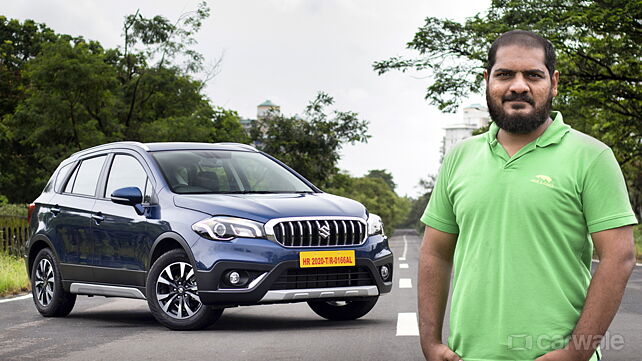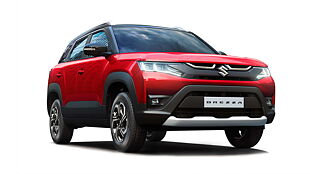What is it?
Why should I buy it?
Refined petrol engine, ease of automatic option, spacious cabin.
Why should I avoid it?
Lacks inspirational value, Could have been loaded with more features and safety equipment.
What is it?

For the first time since its introduction back in 2015, the Maruti Suzuki S-Cross is being offered with a petrol engine. It also gets an automatic for the first time mated to the new K15B engine which also does duty elsewhere in the Maruti’s line-up. This motor also gets the SHVS mild-hybrid system as standard. We first saw it at the 2020 Auto Expo, and now we have driven both the manual and automatic versions of the new BS6 S-Cross petrol in this review.

In terms of styling, Maruti Suzuki hasn’t made any changes to the BS6 S-Cross from the facelift it received back in 2017. Apart from the missing DDiS badge, there’s no way of telling this petrol from the older diesel models. There’s no badge/logo distinguishing the automatic either. So the new S-Cross soldiers on with its amicable styling introduced three years ago, which includes that toothed chrome-surround grille, bulbous headlamps, 16-inch dual-tone alloys and body cladding. Not that the design looks dated, but we think buyers would’ve appreciated if Maruti worked on cosmetic tweaks to make the new S-Cross appear fresher.

How is it on the inside?

Similar to the exterior, the S-Cross is pretty familiar in every possible manner. So what you get is a well-laid out interior which is not only spacious but ergonomic as well. Upfront, the seats are easy to get into, are comfortable and offer ample support. So finding the correct driving position isn’t difficult. You get sufficient headroom, and even the under-thigh support for the seat doesn’t let you down. Visibility is good too, aided further by the door-mounted ORVMs.

There are soft-touch materials used on the centre dash and door pads while the materials used elsewhere in the cabin also have a solid feel to them. For practicality, there are two cup holders, with more stowage place below the centre console, there are armrest storage and large bottle holder on the door pads.

Sitting in the centre of the dash is Maruti’s new seven-inch Smartplay Studio touchscreen, which, as we know, is much better than the older unit. An improvement could have been the coloured MID screen instead of the black-and-white unit we have here.

Getting in the rear bench is easy as well owing to the right seat height and large doors. Once in, there’s more than sufficient legroom on offer. But the headroom is barely enough for me (I am 5.6’) and taller occupants will find it to be a tight fit. Otherwise, the rear is spacious, even for three occupants. There’s no rear AC vent here though. Meanwhile, the large boot space of more than 350 litres is fairly usable owing to the squared floor and less intrusions. You can fold-down the 60:40 rear seats for more space but the seats don’t fold flat.

On the flip side, we think the new S-Cross does miss out on a few key features – even in this top-spec trim. So with the update, we’d have expected features like sunroof, connected car tech, cooled glovebox, and a better sound system. Even on the safety front, the S-Cross could do with more than two airbags, ESP and traction control and front parking sensor.
How does it drive?

Now let’s talk about how the S-Cross petrol drives. Under the hood is the same engine which now does duty in the Ertiga, XL6, Ciaz and also the Vitara Brezza. It is the 1.5-litre four-cylinder naturally-aspirated unit making 103bhp at 6,000rpm and 138Nm of twisting force at 4,400rpm. It’s paired either to a five-speed manual or a four-speed torque converter automatic. Standard with the powertrain is the SHVS mild-hybrid system with an integrated starter generator and Lithium-ion battery helping with brake energy regeneration.

First up, the manual. Crank up the motor and the engine settles into a noiseless idle with no vibrations felt inside the cabin. Depress the clutch – which is light and effortless – and you’d notice how smooth and slick-shifting the gear lever is. Once on the move, there’s an ample amount of low- and mid-range grunt to effortlessly cruise around the city. With the max torque available in the mid-range, it’s where the motor feels the happiest. We also noticed how tractable the motor is. There’s no need to downshift from second- or even third-gear puttering around congested city traffic. However, go over 3,000rpm and the motor gets vocal. But this isn’t an unpleasant din you hear. It instead is, a lovely bawl of a naturally-aspirated four-banger.

So for quick overtakes and a sudden burst of acceleration it is best to keep the engine between 2500-4000rpm. Even though the peak power arrives close to redline at 6000rpm, you never really need to rev all the way to get the most out of this engine. Which means the engine remains mostly unstrained, be it for city usage or highway commutes. Having said that, there’s no way of knowing that the mild-hybrid system is working in the background. There’s, however, a display on the MID screen letting the driver know when the battery is recharged under deceleration, or when it’s aiding the engine in the torque assist.

As for the automatic, the four-speed torque converter is smooth and convenient at sedate speeds. The shifts aren’t noticeable at all and even in kick-down, there’s little to no delay. We don’t expect it to be as quick-shifting or smooth as a dual-clutch unit or a CVT. The torque converter does the job brilliantly in the city. But the limitation of this four-speed unit is felt on the highway where the performance would have felt more relaxed with more cogs since this one’s got fewer gears to play with. In terms of fuel efficiency, Maruti Suzuki claims the motor could do 18.55kmpl paired with a manual, while the automatic is good for 18.43kmpl.

The ride quality in the new S-Cross is still on a firmer side, especially at slow speeds. So the occupants might feel each bump and irregularity inside. But it must be mentioned that the ride doesn’t get to a point of being uncomfortable. It does get better as the speed increases and the S-Cross manages to flatten out everything in its path with ease, even those unexpected potholes on monsoon-ravaged roads. What’s more, the crossover feels planted at triple-digit speeds as well. Meanwhile, the steering is well-weighted too and has good feedback. Although it’s not the quickest, it is direct and remains like that at higher speeds. Lastly, the brakes do a solid job of stopping this 1640kg (gross) crossover as well.

Should I buy one?

The S-Cross has always remained an understated hero in the Maruti Suzuki line-up. It is spacious, well-built, and offers good driving dynamics too. After dropping the desirable yet expensive 1.6-litre diesel it continued only with the 1.3-litre unit, which has now been put to rest as well. But even today, the S-Cross makes sense for someone looking to buy a spacious and inconspicuous crossover, packed in a compact dimension. Sure with the BS6 update, we expected more styling and equipment upgrades, both on the inside and out. Especially since its competition has gone miles ahead now. Adding a mild-hybrid system also makes the petrol motor more frugal. In the end, the Maruti Suzuki S-Cross makes for a great city-slicker and decent highway companion with a hassle-free ownership experience.

Where does it fit in?

Prices for the new S-Cross start at Rs 8.39 lakh and go up to Rs 12.39 lakh (ex-showroom). Which means it makes for an alternative to the likes of the Hyundai Creta, Renault Duster, Nissan Kicks and the new Kia Seltos apart from some variants of the sub-four metre SUVs like Hyundai Venue, Ford EcoSport and Mahindra XUV300.
Pictures by Kaustubh Gandhi

































